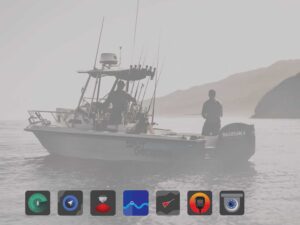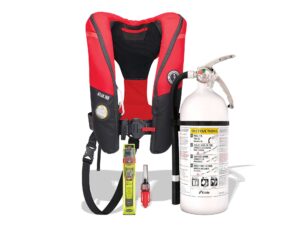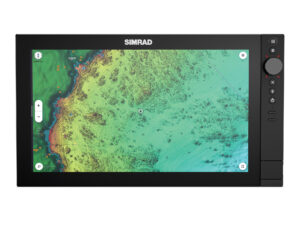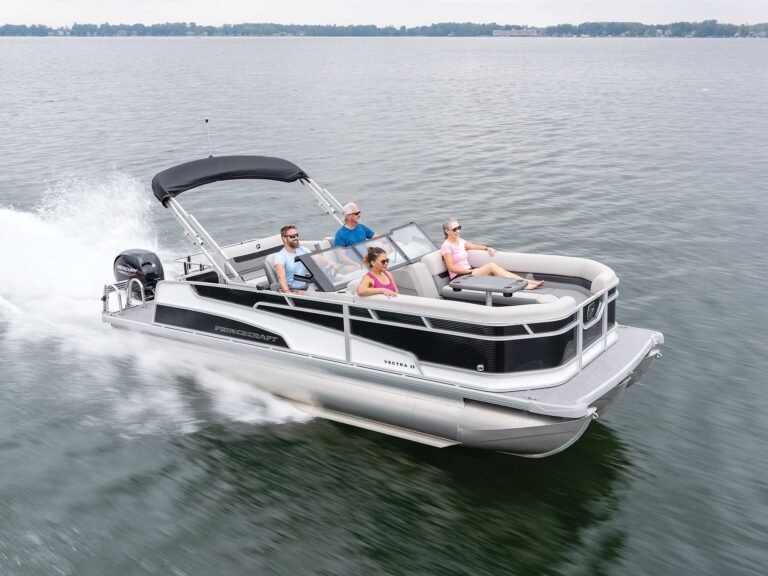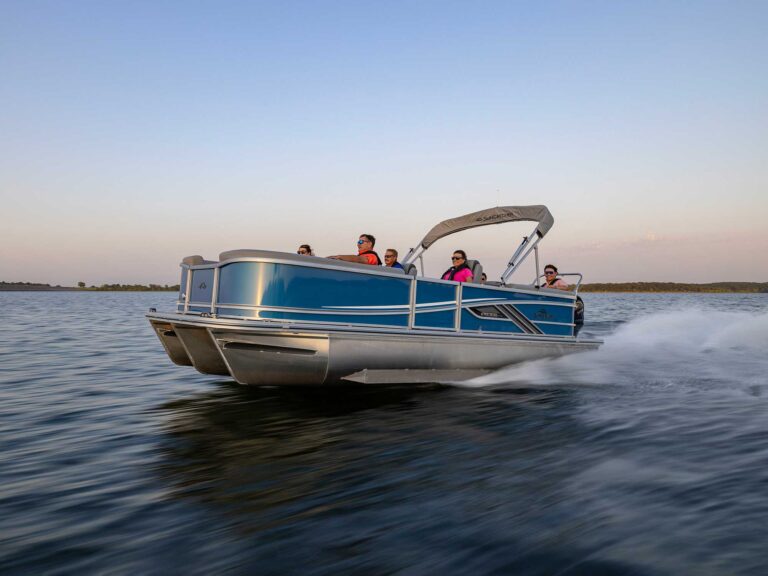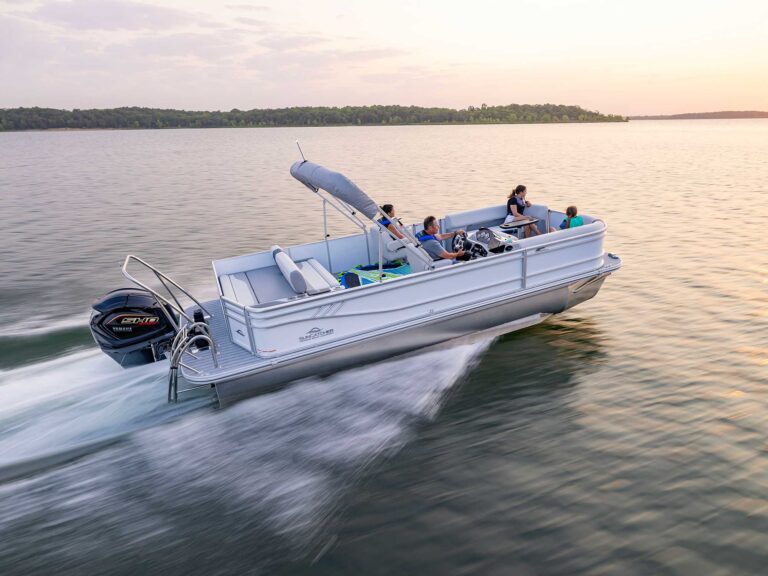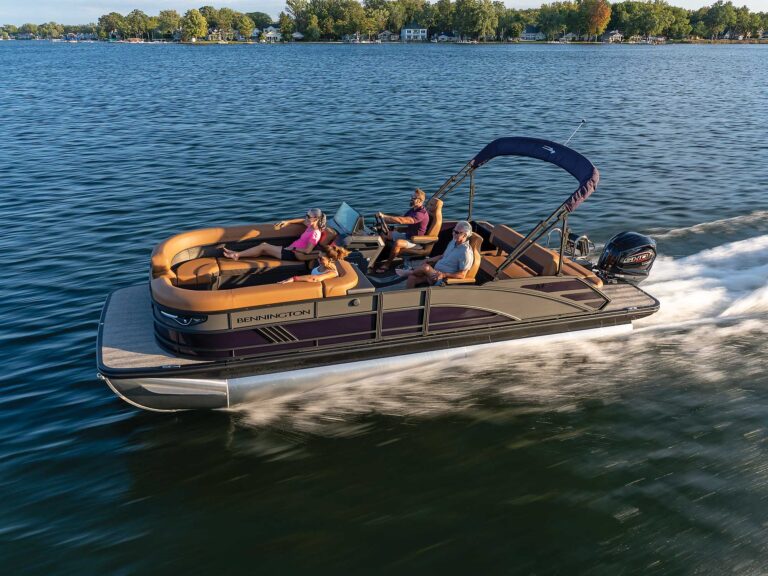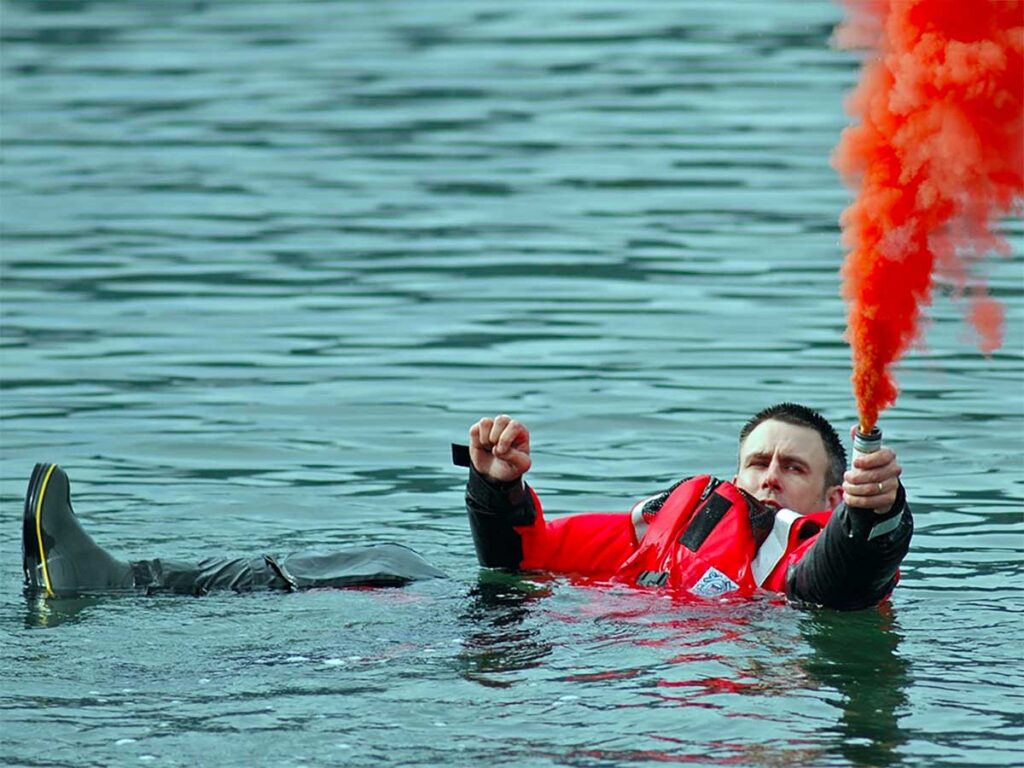
In the event of an emergency on the water it’s essential that boaters in distress are able to signal would-be rescuers, and arguably, nothing does this better than visual distress signals. That’s why the U.S. Coast Guard requires vessels over 16 feet to carry them on most waterways, day and night. Here’s how to choose the right signaling devices for the conditions, when to use them, and how to keep them safely stored on your boat.
Article at a glance:
- The US Coast Guard requires most boats over 16 feet in length to carry visual distress signals suitable for both daytime and nighttime use.
- These signals include pyrotechnic devices such as handheld flares, smoke signals and aerial flares, as well as electronic signals and signal flags.
- Most visual distress signals have a short period of activation, and should be used only when boaters in distress are certain that they will be seen by boat, plane or people onshore.
Types of Visual Marine Distress Signal
As the name implies, visual distress signals are meant to be seen, and as such, produce bright flames, colored smoke, repeating flashes of light, or are simply brightly colored flags. The right signal for the event includes several factors, including day or night lighting conditions. Even the curvature of the earth comes into play.
Pyrotechnic Distress Signals
Pyrotechnic distress signals, commonly called flares, are highly visible and relatively inexpensive. However they burn only for a short period of time, so it’s essential that the boater in peril wait to deploy them until they’re reasonably sure that they will be seen. The U.S. Coast Guard requires boaters have onboard at least three signaling devices rated for day use and three rated for night use. While you could satisfy that requirement with just three day/night rated devices, that’s the bare minimum. Most search and rescue experts recommend carrying at least six signals onboard. Remember that flares expire 42 months after their date of manufacture, so keep tabs on your supply to ensure they have not gone out of date.
Flares come in a wide variety of types, described below. Tip – use aerial signals to attract attention and handheld signals to guide rescuers to your exact position.
- Handheld Flare: Handheld flares produce a bright red flame that’s best seen at night. Though also rated for daytime use, their effectiveness in daylight is minimal. For best results, hold flares by the base at arm’s length using a heat-resistant glove, angling the flare 45 to 60 degrees above the horizon and away from any overhead structures. Flares burn hot and produce dripping “slag” (a heated residue), so hold flares overboard to avoid damaging boat surfaces. Keep the wind at your back so that smoke is carried away. Handheld flares are one-time use; burn time is typically one to three minutes.
- Smoke Flares: Approved for daytime-use only, smoke flares are also considered one of the most effective choices for daylight emergencies. Available as either handheld flares or contained in a floating canister, when activated, smoke flares produce orange-colored smoke for 40 seconds (handheld) to three minutes (canister), and that smoke typically remains visible for minutes after, even in a moderate wind. Always check both wind direction and current before activating so that the smoke produced is carried away from, rather than engulfing, your boat.
- Self-Contained Aerial Flare: Self-contained aerial flares send a firework-like meteor to heights of up to 450 feet, increasing their visibility. Burn time, however, is typically under 10 seconds, prompting the US Coast Guard to suggest that they be sent up in pairs, the second flare being launched as the first extinguishes, to better pinpoint location and direction. Ignition systems include firing tabs or pull cords, typically accessed under a cap at the flare’s base. Point the flare skyward and away from your body before firing.
- Safety Launcher: Pistol-like flare guns, or safety launchers, fire cartridge-contained meteors as high as 1,000 feet, dramatically increasing visibility (21 to 27 miles). Burn time, however, remains short at roughly six seconds. Load flare cartridges into the gun, then fire skyward, again at a 45- to 60-degree angle for best results. Give a flare gun the same respect you’d give any firearm. Avoid overhead objects. Use eye protection or look away when firing to protect your face from discharge and/or sparks.
- Parachute Flare: Available in both self-contained aerial flare cartridges as well as flare-gun cartridges, parachute flares have the advantage of increasing hang time to maximize visibility. Burn times typically range from 25 to 45 seconds. A SOLAS-rated (International Convention for the Safety of Life at Sea) parachute flare can launch as high as 1,000 feet and be visible up to 47 miles away.
– CHECK THE WEATHER –
Safety Tip Provided by the U.S. Coast Guard
The weather changes all the time. Always check the forecast and prepare for the worst case.
Nonpyrotechnic Distress Signals (Electronic Flares and Flags)
- Electronic Flares: Electronic flares, or e-flares, are approved for nighttime-use only and can, at least technically, replace the requirement for one handheld flare. Battery-powered lights use multiple LEDs that flash the universal SOS distress signal in Morse code. Visibility can extend up to 10 miles; battery power can last in excess of 35 hours. Hang or secure e-flares as high as possible to increase visibility. They can also be held by hand, and even taken into the water should you be forced to abandon the vessel.
- Orange Distress Flag: Low-tech but reliable, the classic orange distress flag (typically a 3-by-3-foot orange flag with a black square and circle) is visible at close range and most effective in bright sunlight. Consider hanging the flag on a boat’s rigging or antenna, or waving it attached to a paddle, a boat hook or even a fishing rod to increase visibility.
Read More: Marine Distress Calls Explained
4 Recommended Visual Distress Signals
Visual distress signals are widely available. When choosing, keep in mind where you boat, including how far offshore you may go. We recommend the following products, including a complete kit for best protection, affordable handheld flares, a floating smoke signal and an LED distress light, all from well-known brands in the marine signal market.
Orion 25 mm Alert Locate Plus Signal Kit
This kit provides nearly all the items coastal and offshore boaters require, including a 25 mm safety launcher, four 25 mm red aerial signals, three red handheld flares, two orange smoke signals, a safety whistle, and a signal flag. Exceeds USCG requirements for brightness and burn time. The heavy-duty storage case floats and protects contents, and its bright-orange color is highly visible.
- Type of signal: Day/night, pyrotechnic, aerial and handheld
- Best for: Coastal/Offshore boating day or night
- Required: Satisfies all USCG requirements
- When to check/shelf life: Pyrotechnics expire 42 months after date of manufacture
- Price range: $335 – West Marine Shop Now
Why we like it: Self-contained kit covers multiple needs, includes safety launcher, both handheld and aerial flares, smoke signal, safety whistle, and flag.
Comet Marine/Orion Floating Smoke Signal
Orange smoke flare offers the most obvious, long-lasting visual signal during daylight hours. The buoyant canister doesn’t require a passenger to hold it, freeing them up to do other tasks, and it burns more than three times longer than its handheld alternative.
- Type of signal: Smoke
- Best for: Daytime boating, lasting visual marker
- Required: Satisfies requirement for one of three visual distress signals
- When to check/shelf life: Expires 42 months after date of manufacture
- Price range: $90
Why we like it: Rather than having to be held, a floating signal can be activated and tossed overboard. Highly visible during daylight hours, it lasts longer than a handheld flare.
– UPGRADE YOUR RADIO –
Safety Tip Provided by the U.S. Coast Guard
Digital Select Calling (DSC) allows you to transmit your precise location with the press of a button. Make sure your VHF radio has it, and don’t forget to get your MMSI number. It might just save your life.
Orion Red Handheld Flares Three-Pack
This trio of handheld flares satisfies the USCG requirement for both daytime and nighttime signaling. Flares burn for up to three minutes and produce bright red flame. It’s a low-tech but effective, affordable solution.
- Type of signal: Pyrotechnic
- Best for: Nighttime boating
- Required: Three-pack satisfies requirement for night/day usage
- When to check/shelf life: Expires 42 months after date of manufacture
- Price range: $39 – West Marine Shop Now
Why we like it: Simple, low-tech, inexpensive solution that’s ideal for pinpointing your precise location.
Sirius SOS Distress Light With Flag/Whistle
Electronic SOS Distress Light features an omnidirectional LED visible for up to 10 nautical miles. Flashes a continual SOS pattern for up to 60 hours—four times the USCG requirement. Comes with an orange distress flag for daytime signaling, as well as a whistle to meet audible signal requirements.
- Type of signal: Electronic
- Best for: Nighttime boating, longest run time
- Required: Can satisfy requirement for handheld flares
- When to check/shelf life: Runs on three C batteries
- Price range: $90 – Bass Pro Shop
Why we like it: Visual electronic signal can be seen from both across the water from up to 10 miles away and overhead. Lasts up to 60 hours.
Considerations When Purchasing Visual Distress Signals
In addition to satisfying USCG requirements, there are other factors you should take into account when purchasing visual distress signals.
- Boat Size: Visual distress signals are required for boats 16 feet in length or greater operating on the high seas, coastal waters, the Great Lakes, the territorial seas, and those waters directly connected to the Great Lakes and territorial seas, up to a point where the waters are less than 2 miles wide. For boats 16 feet and under, distress signals are required only when operating between sunset and sunrise.
- Redundancy: While a minimum of three visual distress signals rated for both daytime and nighttime use satisfies the USCG requirement, common sense dictates that additional flares and signals add redundancy.
- Body of Water: Boaters on larger bodies of water should realize that attracting attention might be exponentially more difficult, and should consider options such as aerial flares, which can be seen at far greater distances.
– CARRY A BEACON –
Safety Tip Provided by the U.S. Coast Guard
Satellite beacons such as EPIRBs or PLBs allow boaters to transmit distress signals and their exact coordinates from anywhere on the planet, no cell service required. It may be the best $400 you ever spend.
Closing Remarks & FAQ
Have additional questions about visual distress signals and their use? Find a list of frequently asked questions below.
Which visual distress signals are approved for use at night?
Handheld red flares, launchable aerial flares (including parachute flares), and USCG-approved electronic signals are all acceptable for nighttime use.
Which visual distress signals are approved for day use?
Both handheld and aerial flares are approved for day use, as are smoke flares and signal flags.
How many visual distress signals should you have on your boat?
The USCG stipulates that boats required to carry visual distress signals have a minimum of three signals that can be used both day and night. Boaters have the freedom to decide which devices they want to meet that stipulation. The most common pairing would include three red handheld flares. An electronic signal light could also be combined with a combination of flares and smoke signals. Carry backups in case a signal fails, or if you need to signal multiple times.
What are the legal requirements for visual distress signals?
All recreational boats operating in US coastal waters or the Great Lakes, or bodies of water directly connected to US coastal waters or the Great Lakes up to a point where those waters are less than 2 miles wide are required by law to be equipped with visual distress signals. Exceptions exist for boats less than 16 feet in length, boats participating in organized events, and open sailboats less than 26 feet in length without an engine. Manually propelled vessels are required to carry visual distress signals only at night.
Are electronic flares as reliable as traditional pyrotechnic flares?
Electronic flares are reliable but are only as good as their batteries. Electronic flares or signals generally last far longer than pyrotechnic flares, up to 60 hours.
How should boaters store visual distress signals?
Ideally, store visual distress signals in a waterproof canister or a box that floats, and place that container in an easily accessible location. Bright colors, like orange, will make the container easier to find. Make sure your entire crew knows the location of the distress signals, as well as how to properly use them.
At what distance can visual distress signals be seen?
The curvature of Earth greatly affects any visual distress signal’s ability to be seen. As a rule of thumb, a handheld flare’s line of sight extends to about 5 miles; a 12-gauge meteor can be launched about 250 feet into the air and be visible for about 21 miles; a 25 mm meteor will reach heights up to 375 feet and be visible as far as 27 miles away; and a 25 mm parachute can reach as high as 1,000 feet and extend potential visibility to more than 40 miles.

